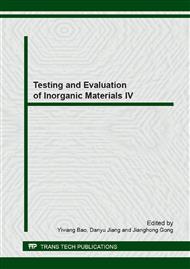p.8
p.12
p.16
p.20
p.26
p.30
p.34
p.40
p.44
Rheological Property of Intercalated Modification Clay
Abstract:
In this paper, the clay was intercalated with polyacrylic acid, and then studied the influences of intercalation on rheological property of ceramic billet. The study indicated that the intercalation changed the properties of clay interlayer domains, such as the interlayer bonding water, the content of free water and the bonding force between the layers, etc. The plasticity index of ceramic billet increased significantly when the amount of intercalation is more than 3.0 wt. The plasticity index increased from 1.09m·N to 4.19m·N when the additive is 5.0wt, increased by 383%. And also its yield strength has improved significantly, the fracture pressure increased from 100N to 600N. These phenomena indicate that the machinability of billet improved significantly.
Info:
Periodical:
Pages:
26-29
Citation:
Online since:
November 2013
Authors:
Price:
Сopyright:
© 2014 Trans Tech Publications Ltd. All Rights Reserved
Share:
Citation:


